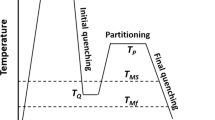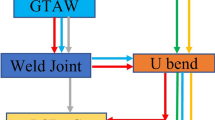Abstract
Improving the strength values of low–medium-strength shipbuilding steels without changing the chemical properties will be very useful to meet the high-strength requirement in ships. Heat treatments and severe plastic deformation methods are the main methods used to increase the strength values of steel without changing the chemical structure. Considering the high improvement effect in strength values, quenching process and equal channel angular pressing (ECAP) method stand out among heat treatments and severe plastic deformation methods, respectively. In the current study, quenching and ECAP were applied to low–medium-strength shipbuilding steel and the changes in microstructure and mechanical properties of steel after these methods were comparatively investigated. While martensite was formed in the microstructure after quenching, the average grain size decreased compared to the base material without a phase change with ECAP. Hardness values increased by 100% after quenching and increased by 80% after ECAP. Yield and tensile strength values increased by 3.3 and 2.5 times, respectively, after quenching. On the other hand, yield and tensile strength values after ECAP raised less than after quenching and increased 1.5 and 1.7 times, respectively, compared to the base material. Impact toughness values decreased by 80% after quenching and 10% after ECAP compared to the base material. Also, corrosion resistance of the base material decreased by 13% after quenching and increased by 10% after ECAP. Changes in the mechanical properties of the material after these processes were reflected the middle section of a ship using finite element-based programs and approximately 3.3 times higher than that of the base material for all dimension load–ultimate strength values under uniaxial compression were reached in the model reflecting the mechanical properties of the quenched samples.









Similar content being viewed by others
Change history
17 October 2021
The volume number given for this article at the head of its title page has been corrected from a previous version.
References
A. Ozekcin, H.W. Jin, J.Y. Koo, N.V. Bangaru, R. Ayer, G. Vaughn, R. Steel and S. Packer, A Microstructural Study of Friction Stir Welded Joints of Carbon Steels. Int. J. Offshore Polar Eng. 2004, 14(4), p 284–288.
D.M. Sekban, S.M. Aktarer, P. Xue, Z.Y. Ma and G. Purcek, Impact Toughness of Friction Stir Processed Low Carbon Steel Used in Shipbuilding, Mater. Sci. Eng. A, 2016, 672, p 40–48.
P. Xue, B.L. Xiao, W.G. Wang, Q. Zhang, D. Wang, Q.Z. Wang and Z.Y. Ma, Achieving Ultrafine Dual-Phase Structure with Superior Mechanical Property in Friction Stir Processed Plain Low Carbon Steel, Mater. Sci. Eng. A, 2013, 575(Supplement C), p 30–34.
R. Song, D. Ponge, D. Raabe, J.G. Speer and D.K. Matlock, Overview of Processing, Microstructure and Mechanical Properties of Ultrafine Grained bcc Steels, Mater. Sci. Eng. A, 2006, 441(1), p 1–17.
V.M. Segal, Materials Processing by Simple Shear, Mater. Sci. Eng. A, 1995, 197(2), p 157–164.
S.-Y. Chen, K.-H. Chen, G.-S. Peng, X. Liang and X.-H. Chen, Effect of Quenching Rate on Microstructure and Stress Corrosion Cracking of 7085 Aluminum Alloy, Trans. Nonferr. Metals Soc. China, 2012, 22(1), p 47–52.
D.V. Edmonds, K. He, F.C. Rizzo, B.C. De Cooman, D.K. Matlock and J.G. Speer, Quenching and Partitioning Martensite—A Novel Steel Heat Treatment, Mater. Sci. Eng. A, 2006, 438–440, p 25–34.
M. Elhefnawey, G.L. Shuai, Z. Li, M. Nemat-Alla, D.T. Zhang and L. Li, On Achieving Superior Strength for Al–Mg–Zn Alloy Adopting Cold ECAP, Vacuum, 2020, 174, p 109191.
Y. Fukuda, K. Oh-ishi, Z. Horita and T.G. Langdon, Processing of a Low-Carbon Steel by Equal-Channel Angular Pressing, Acta Mater., 2002, 50(6), p 1359–1368.
Ö. Güler, N. Bağcı, S.H. Güler, C.A. Canbay, H. Safa, T.A. Yılmaz and M. Taşkın, The Effect of Equal-Channel Angular Pressing (ECAP) on the Properties of Graphene Reinforced Aluminium Matrix Composites, J. Compos. Mater., 2020, 55, p 1749–1768.
F. Hayat and H. Uzun, Effect of Heat Treatment on Microstructure, Mechanical Properties and Fracture Behaviour of Ship and Dual Phase Steels, J. Iron. Steel Res. Int., 2011, 18(8), p 65–72.
C.X. Huang, G. Yang, Y.L. Gao, S.D. Wu and Z.F. Zhang, Influence of Processing Temperature on the Microstructures and Tensile Properties of 304L Stainless Steel by ECAP, Mater. Sci. Eng. A, 2008, 485(1), p 643–650.
G.C. Hwang, S. Lee, J.Y. Yoo and W.Y. Choo, Effect of Direct Quenching on Microstructure and Mechanical Properties of Copper-Bearing High-Strength Alloy Steels, Mater. Sci. Eng. A, 1998, 252(2), p 256–268.
H.Y. Li, X.W. Lu, W.J. Li and X.J. Jin, Microstructure and Mechanical Properties of an Ultrahigh-Strength 40SiMnNiCr Steel during the One-Step Quenching and Partitioning Process, Metall. Mater. Trans. A., 2010, 41(5), p 1284–1300.
X. Li, L. Shi, Y. Liu, K. Gan and C. Liu, Achieving a desirable combination of mechanical properties in HSLA steel through step quenching, Mater. Sci. Eng. A, 2020, 772, p 138683.
A. Ma, J. Jiang, N. Saito, I. Shigematsu, Y. Yuan, D. Yang and Y. Nishida, Improving Both Strength and Ductility of a Mg Alloy Through A Large Number of ECAP Passes, Mater. Sci. Eng. A, 2009, 513–514, p 122–127.
A.A. Popov, A.G. Illarionov, S.I. Stepanov and O.M. Ivasishin, Effect of Quenching Temperature on Structure and Properties of Titanium Alloy: Physicomechanical Properties, Phys. Met. Metallogr., 2014, 115(5), p 517–522.
R. Pourhamid and A. Shirazi, Microstructural Evolution and Mechanical Behaviors of Equal Channel Angular Pressed Copper, Proc. Inst. Mech. Eng. C J. Mech. Eng. Sci., 2019, 234(1), p 171–179.
G. Purcek, H. Yanar, M. Demirtas, Y. Alemdag, D.V. Shangina and S.V. Dobatkin, Optimization of Strength, Ductility and Electrical Conductivity of Cu–Cr–Zr Alloy by Combining Multi-Route ECAP and Aging, Mater. Sci. Eng. A, 2016, 649, p 114–122.
M.J. Santofimia, L. Zhao, R. Petrov, C. Kwakernaak, W.G. Sloof and J. Sietsma, Microstructural Development During the Quenching and Partitioning Process in a Newly Designed Low-Carbon Steel, Acta Mater., 2011, 59(15), p 6059–6068.
P.K. Sarkar and S.K. Kakoty, Effect of Quenching Parameters on Mechanical Properties of Bell Metal, Mater. Today Proc., 2020, 44, p 4179–4183.
V.V. Stolyarov, Y.T. Zhu, I.V. Alexandrov, T.C. Lowe and R.Z. Valiev, Influence of ECAP Routes on the Microstructure and Properties of Pure Ti, Mater. Sci. Eng. A, 2001, 299(1), p 59–67.
T. Tański, P. Snopiński and W. Borek, Strength and Structure of AlMg3 Alloy After ECAP and Post-ECAP Processing, Mater. Manuf. Processes, 2017, 32(12), p 1368–1374.
Y.-X. Zhang, Y.-P. Yi, S.-Q. Huang and F. Dong, Influence of Quenching Cooling Rate on Residual Stress and Tensile Properties of 2A14 Aluminum Alloy Forgings, Mater. Sci. Eng. A, 2016, 674, p 658–665.
M. Demirtaş, Processing of Grade a Low Carbon Steel by Equal Channel Angular Pressing, Nigde Omer Halisdemir Universitesi Mühendislik Bilimleri Dergisi, 2020, 9(1), p 557–564.
C. Ouchi, Development of Steel Plates by Intensive Use of TMCP and Direct Quenching Processes, ISIJ Int., 2001, 41(6), p 542–553.
P. Kumar, C. Xu and T.G. Langdon, Mechanical Characteristics of a Zn–22% Al Alloy Processed to Very High Strains by ECAP, Mater. Sci. Eng., A, 2006, 429(1–2), p 324–328.
O. Saray, G. Purcek, I. Karaman, T. Neindorf and H.J. Maier, Equal-Channel Angular Sheet Extrusion of Interstitial-Free (IF) Steel: Microstructural Evolution and Mechanical Properties, Mater. Sci. Eng. A, 2011, 528(21), p 6573–6583.
J.K. Paik, H. Amlashi, B. Boon, K. Branner, P. Caridis, P. Das, M. Fujikubo, C.-H. Huang, L. Josefson and P. Kaeding. Committee III. 1 ultimate strength, 18th International Ship And Offshore Structures Congress. Schiffbautechnische Gesellschaft eV, 2012, p 285–363.
T.G. Langdon, The principles of grain refinement in equal-channel angular pressing, Mater. Sci. Eng., 2007, 462(1–2), p 3–11.
M. Soleimani, H. Mirzadeh and C. Dehghanian, Phase Transformation Mechanism and Kinetics During Step Quenching of st37 Low Carbon Steel, Mater. Res. Express, 2019, 6(11), p 1165f1162.
Z.Q. Fan, T. Hao, S.X. Zhao, G.N. Luo, C.S. Liu and Q.F. Fang, The Microstructure and Mechanical Properties of T91 Steel Processed by ECAP at Room Temperature, J. Nucl. Mater., 2013, 434(1), p 417–421.
P. Lehto, H. Remes, T. Saukkonen, H. Hänninen and J. Romanoff, Influence of Grain Size Distribution on the Hall–Petch Relationship of Welded Structural Steel, Mater. Sci. Eng. A, 2014, 592, p 28–39.
H.S. Kim, W.S. Ryu, M. Janecek, S.C. Baik and Y. Estrin, Effect of Equal Channel Angular Pressing on Microstructure and Mechanical Properties of IF Steel, Adv. Eng. Mater., 2005, 7(1–2), p 43–46.
T. Niendorf, D. Canadinc, H.J. Maier, I. Karaman and S.G. Sutter, On the Fatigue Behavior of Ultrafine-Grained Interstitial-Free Steel, Int. J. Mater. Res., 2006, 97(10), p 1328–1336.
A. Belyakov, Y. Kimura and K. Tsuzaki, Recovery and Recrystallization in Ferritic Stainless Steel after Large Strain Deformation, Mater. Sci. Eng. A, 2005, 403(1), p 249–259.
W. Łojkowski, On the Spreading of Grain Boundary Dislocations and Its Effect on Grain Boundary Properties, Acta Metall. Mater., 1991, 39(8), p 1891–1899.
D.H. Shin, Plastic Flow Characteristics of Ultrafine Grained Low Carbon Steel During Tensile Deformation, Met. Mater. Int., 2001, 7(6), p 573–577.
V.M. Segal, Equal Channel Angular Extrusion: From Macromechanics to Structure Formation, Mater. Sci. Eng. A, 1999, 271(1), p 322–333.
C. Xu, M. Furukawa, Z. Horita and T.G. Langdon, The Evolution of Homogeneity and Grain Refinement During Equal-Channel Angular Pressing: A Model for Grain Refinement in ECAP, Mater. Sci. Eng., A, 2005, 398(1), p 66–76.
Q. Xue, I.J. Beyerlein, D.J. Alexander and G.T. Gray, Mechanisms for Initial Grain Refinement in OFHC Copper During Equal Channel Angular Pressing, Acta Mater., 2007, 55(2), p 655–668.
Y.T. Zhu and T.C. Lowe, Observations and Issues on Mechanisms of Grain Refinement During ECAP Process, Mater. Sci. Eng. A, 2000, 291(1), p 46–53.
P.K. Katiyar, S. Misra and K. Mondal, Comparative Corrosion Behavior of Five Microstructures (Pearlite, Bainite, Spheroidized, Martensite, and Tempered Martensite) Made from a High Carbon Steel, Metall. Mater. Trans. A., 2019, 50(3), p 1489–1501.
M. Soleimani, H. Mirzadeh and C. Dehghanian, Unraveling the Effect of Martensite Volume Fraction on the Mechanical and Corrosion Properties of Low-Carbon Dual-Phase Steel, Steel Res. Int., 2020, 91(2), p 1900327.
W.R. Osório, L.C. Peixoto, L.R. Garcia and A. Garcia, Electrochemical Corrosion Response of a Low Carbon Heat Treated Steel in a NaCl Solution, Mater. Corros., 2009, 60(10), p 804–812.
A. Di Schino and J.M. Kenny, Effects of the Grain Size on the Corrosion Behavior of Refined AISI 304 Austenitic Stainless Steels, J. Mater. Sci. Lett., 2002, 21(20), p 1631–1634.
M. Hasegawa and M. Osawa, Corrosion Behavior of Ultrafine Grained Austenitic Stainless Steel, Corrosion, 1984, 40(7), p 371–374.
Acknowledgments
I would like to thank to Professor Gencaga Purcek (Mechanical Engineering Department, Karadeniz Technical University) for sharing his laboratory facilities.
Author information
Authors and Affiliations
Corresponding author
Additional information
Publisher's Note
Springer Nature remains neutral with regard to jurisdictional claims in published maps and institutional affiliations.
Rights and permissions
About this article
Cite this article
Sekban, D.M. Effects of Heat Treatment and Severe Plastic Deformation on Microstructure, Mechanical Properties and Midsection Ultimate Strength of Shipbuilding Steel. J. of Materi Eng and Perform 30, 7805–7816 (2021). https://doi.org/10.1007/s11665-021-06114-3
Received:
Revised:
Accepted:
Published:
Issue Date:
DOI: https://doi.org/10.1007/s11665-021-06114-3




